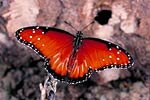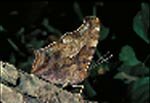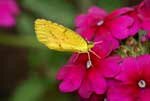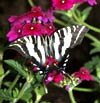|
Common Name: Buckeye
Scientific Name: Junonia coenia
Description: Found throughout much of North America, but not able to overwinter very far north. In the autumn along the east coast they migrate south in large groups. The Buckeye's telltale eyespots can be effective in scaring off predators.
|
 |
|

|
Common Name: Cloudless Sulphur
Scientific Name: Phoebis sennae
Description: Summer movements bring this butterfly to states far north of its winter range, and autumn emigrations greatly reinforce its northern numbers, sometimes introducing millions to relatively small areas. This butterfly's appearance in the Rockies or New York is a real event. Yet all of these northern emigrants die without returning south. |
|
Common Name: European Cabbage White
Scientific Name: Pieris rapae
Description: The Cabbage White is possibly the most common butterfly species in the world. This species was introduced from Europe around 1860. It prefers open weedy areas, cities, gardens, agricultural fields, and ranges from the coast to the desert.
|
 |
|
|
Common Name: Giant Swallowtail
Scientific Name: Heraclides cresphontes
Description: One of the largest North American butterflies (up to 5 ½ inches). They are sometimes considered a pest by citrus growers and are subject to spraying efforts. This species is capable of flying long distances and occasionally strays into northern and mid western states. |
|
Common Name: Great Southern White
Scientific Name: Ascia monuste
Description: Male and females are dimorphic (look different). Males are white with pointed, full wings. Charcoal scales dust tips and surrounding veins. Females are either like males but with darker margins, or entirely suffused with smoky brown or gray scales. This species builds up to enormous numbers prior to northerly emigrations. The mass movements are very impressive - for days, the large butterflies pass in small clusters, flying in a rapid and very directed manner.
|
|
|

|
Common Name: Gulf Fritillary
Scientific Name: Agraulis vanillae
Description: As its name implies, this beautiful insect haunts the Gulf of Mexico, and may be seen flying far out over the water. Colonization of the North is temporary, as neither the butterfly nor its host plants can withstand northern winters. |
|
Common Name: Julia
Scientific Name: Dryas julia
Description: The Julia differs in several respects from the other longwings. The female's duller coloring may protect its valuable egg load from attack by predators. The Julia is also thought to be distasteful because its caterpillars feed on poisonous passion flowers. Adults are vigorous fliers but often stop to take nectar at flowers.
|
 |
| |
Common Name: Long Tailed Skipper
Scientific Name: Urbanus proteus
Description: Considered a pest by farmers and gardeners because of their caterpillars fondness for bean leaves. It is sometimes called a bean-leaf roller although it eats a variety of host plants. |
|
Common Name: Malachite
Scientific Name: Siproeta stelenes
Description: A newly emerged malachite is very bright but their marble green color fades with exposure to sunlight. Malachites may feed all day long and may fly to flowers 38 feet high in the canopy. A southern Florida populations has been establisthed since the 1960s; presumably having emigrated from Cuba.
|
 |
|
|
Common Name: Mourning Cloak
Scientific Name: Nymphalis antiopa
Description: This butterfly camouflages itself against dark bark when at rest. They show a great contrast between under and upper sides. When startled into flight, they may emit an audible click sound. Mourning Cloaks are one of the few butterflies that overwinter as adults. Adults emerge in mid-summer and fly into the fall. After overwintering, they fly again in early spring. |
|
Common Name: Orange-barred Sulphur
Scientific Name: Phoebis philea
Description: The Orange-barred Giant Sulphur has been established in southern Florida since the 1930's. It is a powerful speedster in flight, but pauses often to probe for nectar from many kinds of flowers.
|
|
| |
Common Name: Palamedes Swallowtail
Scientific Name: Papilio palamedes
Description: This butterfly is the signature swallowtail of the great swamps - the Everglades, the Great Dismal, Okefenokee, Okeechobee, and Big Cypress. In common with many swamp skippers, the adults love to take nectar from pickerelweed, and they are reported to roost communally in oaks and palmettos. |
|
Common Name: Pipe-vine Swallowtail
Scientific Name: Battus philenor
Description: Pipe-vine Swallowtail Battus philenor Horticulture has increased the rangeof host plants, so this butterflys range has expanded over the years. The vines that these caterpillars feed on is rather distasteful. The butterflies retain the unpleasant taste, causing birds to avoid them. Several other butterflies mimic this butterflys pattern. This mimicry may also protect them from predation.
|
|
|

|
Common Name: Queen
Scientific Name: Danaus gilippus
Description: The Queen cannot withstand cold winters. Records for northwestern Utah, Nebraska, and Kansas represent temporary immigrations. Male Queens possess brushes, or hair pencils, within the tips of their abdomens. As courtship begins these brushes are extended, releasing a compound that subdues the female during mating. |
|
Common Name: Question Mark
Scientific Name: Polygonia interrogationis
Description: The Question Mark is not found west of the rockies. Like the other anglewings, the adult Question Mark loves sap and rotting fruit. Normally highly alert, these butterflies can actually become intoxicated if the fruit they are drinking has fermented in the sun.
|
 |
|

|
Common Name: Red Admiral
Scientific Name: vanessa atalanta
Description: This species moves north in the spring and also shows some evidence of a loose migration south in the fall. If the winter is mild, some individuals may overwinter in the north, but are not usually year-round residents in freezing climates. Adults frequently land on people and seem to prefer white t-shirts. |
|
Common Name: Red-spotted Purple
Scientific Name: Limenitis arthemis astyanax
Description: The Red-spotted Purple is a mimic of the toxic Pipevine Swallowtail Along the northern edge of its range, the Red-spotted Purple hybridizes with the White Admiral to produce partially banded offspring. Some lepidopterists consider them one species, but genetic evidence suggests that they have come together relatively recently.
|
|
| |
Common Name: Ruddy Daggerwing
Scientific Name: Marpesia pretreus
Description: Such a bright, large butterfly draws the attention of birds; perhaps the hooked fore wing tips and hind wing tails divert attacks from vital parts. While the caterpillars thrive on fig leaves, adults love rotting figs, other fruits, and giant milkweed. |
|
Common Name: Sleepy Orange Sulphur
Scientific Name: Eurema nicippe
Description: This sulphur cannot withstand cold winters yet annually penetrates the northerly latitudes - a characteristic pattern of many North American butterflies. The common name, Sleepy Orange, may have come from the butterfly's habit of hibernating through the cooler days of the southern winter. In summer it seems anything but sleepy with its rapid flight.
|
 |
|
|
Common Name: Spicebush Swallowtail
Scientific Name: Pterourus troilus
Description: This butterfly is a Pipevine Swallowtail mimic. This species is native to eastern North America, but on rare occasions strays into Colorado. It is not uncommon to find large numbers of spicebush swallowtails gathered at a roadside puddle. Like many other butterflies, males gather at these mud puddles to take up salts and minerals essential for sperm production. |
|
Common Name: Varigated Fritillary
Scientific Name: Eutoieta claudia
Description: The caterpillars of this species eat more different types of plants than those of almost any other butterfly except the Painted Lady. Both caterpillar and chrysalis are among the most beautiful of all in our range.
|
|
|

|
Common Name: Viceroy
Scientific Name: Limenitis archippus
Description: The adult, famed as a mimic, resembles the distasteful Monarch. Since birds learn Monarchs are distasteful, they also avoid the look-alike Viceroy. Southern populations of Viceroys mimic the much deeper chestnut- colored Queen instead. In flight, the Viceroy flaps frenetically in between brief glides. |
|
Common Name: White Peacock
Scientific Name: Anartlia jatrophae
Description: Much more limited to the Tropics than its relative the Buckeye, the White Peacock also invades the North. However, it is neither as strong a flier nor as hardy as the Buckeye, and remains a rarity outside its southern strongholds.
|
 |
|
|
Common Name: Zebra Longwing
Scientific Name: Heliconius charitonius
Description: The zebra longwings flight is slow, feeble and wafting. But, if necessary they may dart quickly to shelter. They roost together at night, gathering at dusk. |
|
Common Name: Zebra Swallowtail
Scientific Name: Eurytides marcellus
Description: Occurs only near pawpaw plants (or its relatives). They usually fail to adapt to suburban growth and development so their numbers are declining in many areas.
|
 |


